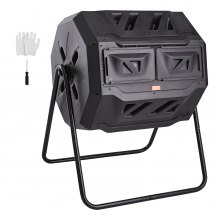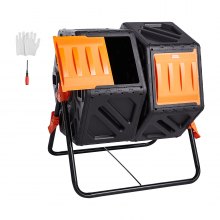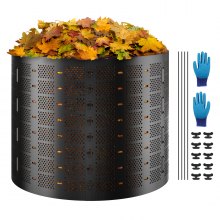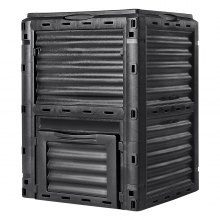Use VEVOR Compost Tumbler For Faster Composting And Nutrient Soil
A Compost tumbler is a machine that helps to decompose organic waste materials faster. It aids by mixing and aerating such items while decomposing them quickly. High-quality composter tumblers from the VEVOR offer you an opportunity to get nutrition-rich soil for your garden through organic means only. Read further in this article on how efficient these compost tumblers are and their advantages over others.
Understanding Compost Tumbler
A rotating container that hastens composting is called a compost tumbler. It consists of an airtight drum that can be rotated for mixing of the contents, thereby allowing for even ventilation and quick breakdown of raw manure. This approach is efficient in producing high-quality manure for your garden.
Types Of Compost Tumblers
Some of the most common types of compost tumblers are as follows:
Single Chamber Compost Tumbler
It is commonly known and has only one rotating bin for composting. This type is easy to use and can be used by small to medium-sized family members.
Double Chamber Compost Tumbler
You can make compost in one chamber while storing finished compost in the other. It is perfect for continual decomposition.
Electric Compost Tumbler
A tumbler that moves on its own with the aid of electricity, thus saving time and energy spent on rotation. It is suitable for large piles of compost and physically challenged individuals.
Compost Tumbler Powered By The Sun
The type of tumbler that uses solar power such that it makes sure you cost-effectively conserve your environment. It perfectly suits those who wish to develop ecologically friendly landscaping.
Below are factors to consider when choosing the best composter:
Capacity
Evaluate how much compost you need. Buy a container that takes what you want. Larger barrels may be required for prominent families or those with lots of garden refuse.
Material
Ensure you get a firm material, such as plastic or galvanized steel, since the weather affects them. Thus, it should be sturdy to resist external forces.
Turning Mechanism
Look at how easy it is to turn around your manure. Such changes include handles, gears, or built-in turning mechanisms that make this task effortless.
Ventilation
Ensure aeration in your decomposing materials by opting for a barrel with many air vents that present enough oxygen supply around them.
Accessibility
To facilitate the addition and removal of organic matter, choose bins with bigger openings or removable covers to reach inside without any problem quickly.
Why VEVOR Compost Tumblers Are the Best
VEVOR compost tumblers provide several benefits to ensure effective and easy composting:
Strongly Made
Made using durable materials, such as galvanized steel or heavy-duty plastic, VEVOR tumblers are created for outdoor use and are resistant to rusting or corrosion.
Effortless Mechanism
Our tumblers have a smooth and easy rotating mechanism that allows you to mix your compost with less strength. Enjoy the convenience of trouble-free composting.
Ventilation
The VEVOR tumbler provides excellent airflow in the compost, which hastens the decomposition process while minimizing foul odors. The ventilation design enables even airflow within, resulting in faster outcomes.
Large Size
The large compartments in the VEVOR tumbler can hold tons of organic waste. Thus, you do not need to empty it now and then. Explore this large VEVOR Compost Bin 220 Gallon.
Easy To Use
All our compost tumblers have been designed with simplicity in mind. Explore this VEVOR Garden Compost.
Recommendations And Testimonials
The following are the top rated VEVOR Compost Tumblers. Explore them below.
VEVOR 5-Tray Worm Composter
VEVOR 5-Tray Worm Composter is a flexible and efficient solution for easy composting of the material into organic nutrients for plants. It has an expandable structure and many trays for making nutritious worm castings. This compost is made up of durable material which lasts long.
Testimonial: Awesome worm bin ready to use and easy. Scalable for any household. Fun kid project as well. Will buy again. Drayco
VEVOR Compost Bin
VEVOR Compost Bin is designed to be spacious and make it easy to recycle organic products. It is perfect for producing nutrient-rich garden compost through its dual-chamber system and features that make usage convenient.
Testimonial: I like this set up. Everything to get you started. Directions are good. Best value over others. Built well for what it is.Scott W.
FAQs
How Often Should I Turn My Compost Tumbler?
Aim to turn your compost tumbler once a week so that adequate moisture is provided and air circulation is good. This speeds up the process of decomposing organic matter into humus fertilizer.
What Can I Put In A Tumbler?
Examples of items in a tumbler include fruit and vegetable scraps, grass clippings, coffee grounds, and tea bags. Avoid meat or dairy products as well as any greasy substances.
How Long Does It Take To Make Compost In A Tumbler?
The time it takes for composting to occur depends on the temperature, moisture content, and types of items used. On average, producing finished compost will take about 4-6 weeks.
Can You Have A Compost Tumbler Inside Your House?
Some tiny compost tumblers can be kept indoors, but adequate ventilation is essential to avoid unpleasant odors. This is because people find it convenient for outdoor composting.
How Do I Keep My Compost Tumbler Working Properly?
Check the moisture level regularly. Top up with water if necessary. Periodically clean your composter to get rid of debris. Also, store it in a sheltered place when it is not in use.
Conclusion
A composting tumbler provides an efficient and convenient way of turning organic garbage into nutrient-rich organic fertilizer. It speeds up the decomposition process through the fast processing of pure humus and offers a clean environment free from smell caused by decomposing organic matter. VEVOR offers various high-quality composting tumblers that exactly match your needs! Shop VEVOR Compost Tumbler now.

















































































































